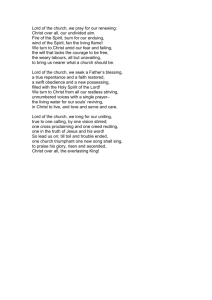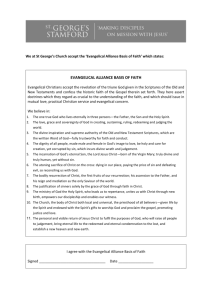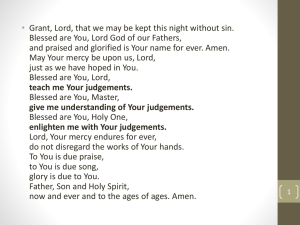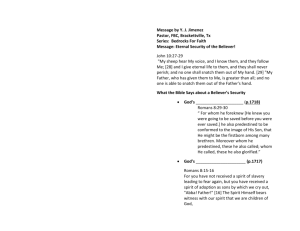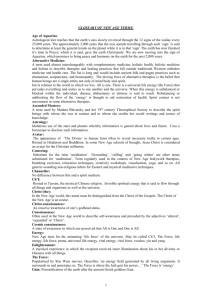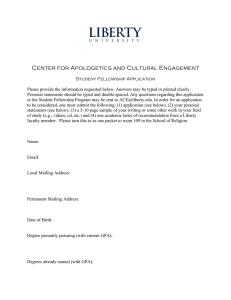Conceptual Foundations for Theosis and Post-Modern Theology The Orlando Institute
advertisement
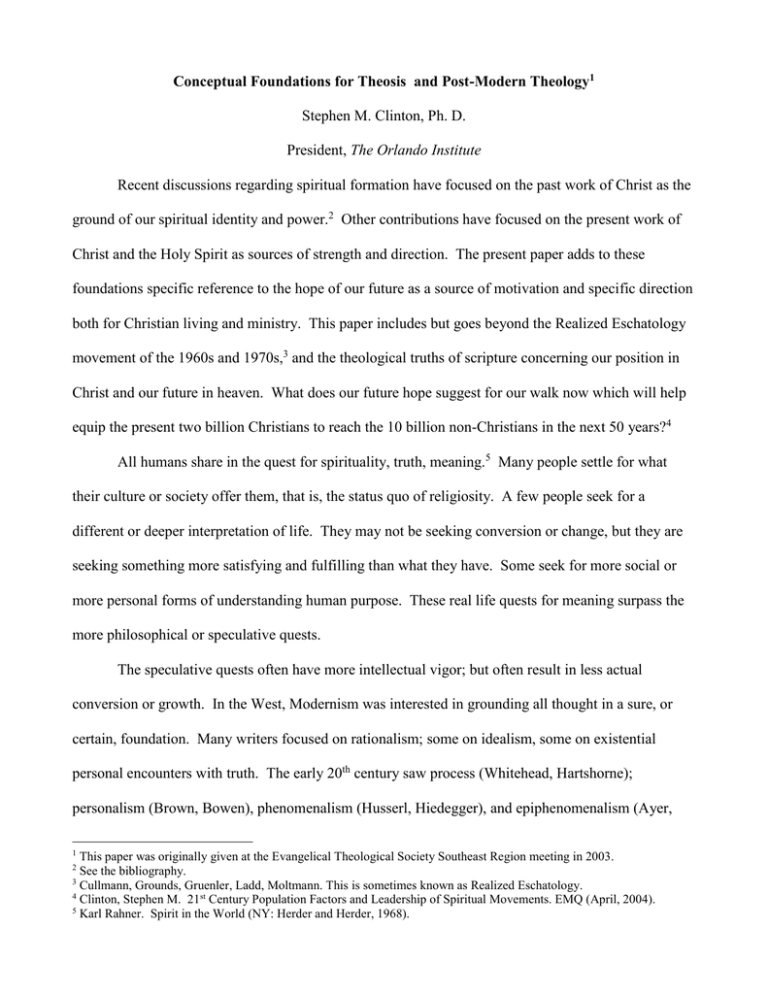
Conceptual Foundations for Theosis and Post-Modern Theology1 Stephen M. Clinton, Ph. D. President, The Orlando Institute Recent discussions regarding spiritual formation have focused on the past work of Christ as the ground of our spiritual identity and power.2 Other contributions have focused on the present work of Christ and the Holy Spirit as sources of strength and direction. The present paper adds to these foundations specific reference to the hope of our future as a source of motivation and specific direction both for Christian living and ministry. This paper includes but goes beyond the Realized Eschatology movement of the 1960s and 1970s,3 and the theological truths of scripture concerning our position in Christ and our future in heaven. What does our future hope suggest for our walk now which will help equip the present two billion Christians to reach the 10 billion non-Christians in the next 50 years?4 All humans share in the quest for spirituality, truth, meaning.5 Many people settle for what their culture or society offer them, that is, the status quo of religiosity. A few people seek for a different or deeper interpretation of life. They may not be seeking conversion or change, but they are seeking something more satisfying and fulfilling than what they have. Some seek for more social or more personal forms of understanding human purpose. These real life quests for meaning surpass the more philosophical or speculative quests. The speculative quests often have more intellectual vigor; but often result in less actual conversion or growth. In the West, Modernism was interested in grounding all thought in a sure, or certain, foundation. Many writers focused on rationalism; some on idealism, some on existential personal encounters with truth. The early 20th century saw process (Whitehead, Hartshorne); personalism (Brown, Bowen), phenomenalism (Husserl, Hiedegger), and epiphenomenalism (Ayer, 1 This paper was originally given at the Evangelical Theological Society Southeast Region meeting in 2003. See the bibliography. 3 Cullmann, Grounds, Gruenler, Ladd, Moltmann. This is sometimes known as Realized Eschatology. 4 Clinton, Stephen M. 21st Century Population Factors and Leadership of Spiritual Movements. EMQ (April, 2004). 5 Karl Rahner. Spirit in the World (NY: Herder and Herder, 1968). 2 Russell). Other philosophies gave up the search for truth and simply sought coherent meaning, e.g. analytic philosophy and pragmatism. By 1980 Rorty, and others, gave up the search for meaning and simply sought interesting dialog about important questions. This is in keeping with the post-modern spirit which rejects any truth or meaning other than personal ascriptions of value. For those who already have contact with true spiritual reality, that is, a life of faith and grace through Jesus Christ, the life journey is to walk deeper with Christ and to experience more of God in daily life. It is not that God is hidden, at least most of the time. It is that we need to find ways to see Him in life, to touch Him in prayer or contemplation, to experience Him in our spirit or through life experiences (eg. books by Foster, 1978). Willard6 has made the point that most of us simply need to understand what the presence of God is like and how to observe what is already around us. But the heart is rarely satisfied for long with the observation of the hand of God in nature or the providential actions in our behalf. We want to know Him more personally. Perhaps this is an outcome of our preoccupation with personal application in the modern West. Beyond our personal external experience are the social facts that we may well experience more of God in social settings, such as worship services or group retreats, and the reality that we may minister effectively in the lives of others to help them grow closer to Christ, and in the process see our own growth stimulated. Christianity finds its highest expression in this life when believers, led and empowered by the Holy Spirit, minister directly to the spirit’s of other people, via conviction, evangelism, communicating truth, worshipping together. There have been a number of efforts to quantify the steps of spiritual growth. The Engle scale7 proposed twelve steps or levels in coming into a relationship with Christ and seems objectively very accurate. More useful in terms of growth has been the pioneering work of Eric Erickson on stages of life growth.8 6 Willard, Dallas. Hearing God (Downers Grove, IL: IVP, 1999). Engle, James. How Can I Get Them to Listen? (Grand Rapids: Zondervan, 1977). 8 Erickson, E. H. Dimensions of a New Identity (New York: Norton, 1978). 7 Most religious growth hierarchies9 approach only the psychological aspects of faith, that is, the steps in developing a deeper psychological faith. These hierarchies do not examine the role of the Holy Spirit in helping us grow. Other authors10 list from four to eight levels of spiritual growth for those who are already Christians. Paul uses two levels (milk, meat) and John uses three (children, men, fathers). I see no simple answer to how many levels or steps of spiritual growth one can use. More to the point is the nature of the process of growth. The development of values, leading to spiritual formation, was begun by Krathwold11 and Kohlberg. Krathwold’s work on the affective domain is a foundation which many educators use when planning educational curricula. Counselors and disciplers use the same model to help people reach serious character formation. Kohlberg identified six stages of moral growth and gave example of each stage. He postulated the idea of a seventh stage of moral development in which one reaches a “unitive” stage of growth which assimilates moral and religious experience.12 The research in this tradition of moral development continues today.13 Again, no consensus is apparent. Theosis, becoming one with God, goes beyond all these experiences. It implies that a human can somehow become one with the God of the universe, thereby incorporating and transcending reality, a kind of reverse incarnation.14 Some people teach that this has been our human destiny, to be joint heirs with Christ has been God’s plan all along.15 Implied in this process of theosis is both a conception of reality and an investment of meaning in that conception far beyond what philosophers, who are not also theologians, have ever brought under study. Other writers believe that theosis in II 9 Especially Fowler, J. Life Maps (Waco, TX: Word, 1978); and Lawrence Kohlberg. The Philosophy of Moral Development (San Francisco: Harper & Row, 1981). 10 Eims, Leroy. The Lost Art of Disciplemaking (Colorado Springs: NavPress, 1970); Clinton, Stephen M. and Alan Scholes. “Levels of Belief,” Journal of the Evangelical Philosophical Society (14:2, 1991). 11 David Krathwold. “Taxonomy of the Affective Domain,” in Taxonomy of Educational Objectives, edited by Benjamin Bloom and David Krathwold (NY: David McKay, 1964). 12 Lawrence Kohlberg and Clark Powers. “The Question of a Seventh Level,” in Lawrence Kohlberg's approach to moral education (NY: Columbia Univ. Press 1989). 13 J. Jovonen, & K. Wentzel. Affective Motivation (Cambridge: Harvard, 1996). 14 Georgios Mantzaridis, The Deification of Man (New York: St. Vladimir’s Seminary Press, 1984). 15 Barnhouse 1965, Clinton 1987, Nouwen 1992, Pinnock 1996, Curtis. & Eldredge 1997, Mascetti 1998, Lawrenz 2000, Larsen 2001. Peter is the same as our fellowship with God described in Matt. 5, Romans 8, the Gospel of John, and I John.16 The remainder of this paper will examine the conceptual foundations and philosophical implications of theosis and describe ways these can be held and presented in a post-modern context. I. Biblical teaching regarding theosis Direct biblical teaching is minimal. The passage which actually uses this word and teaches the idea is II Peter 1:4 “For by these He has granted to us His precious and magnificent promises, so that by them you may become partakers of the divine nature, having escaped the corruption that is in the world by lust.” The key phrase “partakers of the divine nature” is ge,nhsqe qei,aj koinwnoi. fu,sewj.. This is literally “becoming in fellowship with God’s nature.” The subjunctive aorist verb is deponent, implying something like, “so that you will become.” The middlepassive sense of the deponent is that something (in Orthodox thought, the Holy Spirit) is at work to lead to this end. The word nature is used in Galatians (2:15; 4:8) and Ephesians (2:3) to refer to an old or new nature. The phrase “sharers in the divine nature” sounds philosophically different than the usual English translation which is “become partakers.” “Become partakers” sounds like a direct participation in the divine, that is, we become God. Sharing in (koinonia) gives more sense of active participation, personal and intimate fellowship, which implies the same closeness and experience of divinity, but does not have the same metaphysical issues. The passage means that the work which has begun in us will continue till we are sharers in God’s nature. This sounds parallel to Colossians 1:1617, which says that the world was created by Christ and for Him. If the world, and universe, is created for Christ, then the whole universe is the place for the second person to be who he is and act in keeping with his nature. And we are created to be his brothers and sisters, for ever. The final phrase in the II Peter passage says that in the process of growing spiritually we will escape the corruption of the world. 16 Reicke 1964, Rahner 1968, Moltmann 1977, Richards 1987, Smith 1995, Dupre 1998. These seems to be two sides of a coin. We growth in godliness and move away from corruption. This, too, has been part of the plan since the beginning. This reminds us of I John 1: 3 “and indeed our fellowship is with the Father, and with His Son Jesus Christ.” The Greek shows the parallel use of koinonia: kai. h` koinwni,a de. h` h`mete,ra meta. tou/ patro.j kai. meta. tou/ ui`ou/ auvtou/ VIhsou/ Cristou/Å John’s point is that we already have this fellowship and we are encouraged to walk in it and rejoice in it. Peter’s use talks about the outcome of the process: god-like-ness in unity and fellowship, perhaps alos in nature. This point of understanding theosis as culminative was developed by the church Fathers. The fathers employed a number of descriptions for final salvation, including “illumination;” “regeneration” and “purification.” These all indicate a move toward a goal. One image took the preeminent place in Eastern theology - the description of theosis. It is commonly described as “deification” or “divinization.”17 Though theosis appeared as early as Ignatius of Antioch and Justin Martyr, it was developed theologically by Irenaeus, Athanasius, and the Cappadocian fathers, especially Gregory, in the second and third centuries.18 Other topics and verses regarding seeing our life now from the perspective of our future are given here in list form: Sharing in the divine nature II Pet. 1:4 Transformation Rom 12:2 II Cor 3:18; 5:17 Perfection Mt 5:48 2 Cor. 7:1 Eph. 4:13 Col 1:28; 2:10 I Jn 2:5 4:17 Perfected in Love Jn. 17:23 Phil 3:12 Col. 3:14 Heb. 10:14 1 Jn. 4:12, 17-18 God-like Rom 8:29 I Cor 15:49 Eph 3:19 I Jn 3:2 All riches Eph. 2:4-7 Judge angels 1 Cor. 6:3 17 See Justin Martyr Apology 2.13 (ANF 1:193); Irenaeus Against Heresies 5.17.3 (ANF 1:545) and 5.17.3 (ANF 1:545); Justin Martyr Apology 1.12-19 (ANF 1:166–69); 1.66 (ANF 1:185). 18 K. E. Kirk, The Vision of God. Longmans, Green & Co., 1931, p. 129ff. United with all believers of all ages Heb. 12:1 Rev. 21:3, 7 II. Modern Commentators and Theologians Patristic and Orthodox theologians believed theosis to be the primary work of salvation. In this way, much like Realized Eschatology, the end of our walk is in view from the beginning. Five considerations about theosis that pertain to soteriology are as follows: theosis explains man’s soteriological need as the restoration of eternal life which began in the garden, and is our human destiny; theosis teaches that salvation happens through reunion with uncreated grace, that is, as a supernatural act of change in us; theosis explains salvation in terms of resurrection and glorification, sanctification and its doctrines are a means to the end; theosis makes a clear distinction between the essence and energies of God; and, theosis forms a basis for Christology, including incarnation, atonement, and ascended being. In the past many exhortations to “live life differently because of our future in heaven” have been made by preachers and writers based on general information, such as, we will be holy, so be holy now. A foundation for newer more specific direction, was begun by Barth, expanded in the Realized Eschatology movement of the 1960s and 1970s, and specific theological truths of scripture were developed concerning our position in Christ and our future in heaven. One of the ways spirituality is developed is through human interaction. This aspect is the process of the mutual discipleship of the community, or the practice of body life, with or without a spiritual director. In the U. S. most recent research has been on small group interactions as part of a personal discipleship process (Dieter, 1987; Richards, 1987; Clinton, 1994; George, 1997). In the Eastern context Russian educators, especially Vygotsky (1985), have worked more than anyone on the stages of the process of social development of humans (Williams, 1989). The most complete development is in the work of Moltmann.19 I will simply outline his nine major points. He divides these into two groups: the church in the presence of the Spirit, and the church in the power of the Spirit. The presence of God, the Spirit, is seen in the preaching of the gospel in transforming power, in the power of baptism in the renewing process, the Lord’s Supper as a show of the presence of the coming Lord, in worship as a feast and ritual in the midst of life, and in the meaningful history of each individual life, as the person lives in the power of the Spirit. The power of God is seen in the nature of the community of the church as individuals are transformed through interaction of gifts and calling and in charismatic fellowship, in the charge to the community to be the people of God in the midst of time and in the fulfillment of the Great Commission to plant churches and make disciples everywhere, and in the organizational fellowship and cooperation of ministries (church and parachurch) around the world. Conclusion: In a post-modern time we need to show both that the lived experience of a relationship with God is actual and that there is a point from which a genuine life perspective is possible, namely from the future. We live in the present with expectation of future participation in God: anticipation and hope in the midst of pain, degradation, angst, and spiritual warfare, because we know that our future and the world’s future is assured of victory. We can directly address hearts, spirits, (angels, demons) and spiritual issues because we know of the reality of the spiritual world via Christ and the resurrection. We seek total personal transformation as an ongoing process (and death to self) because that is our promised future. Every personal encounter is a divine appointment for kingdom action because God has left us here in the interim with a specific purpose. We look at all relationships from the perspective of the future judgment, called the Judgment Seat of Christ. We love because it is our nature, because it is our duty, because we will be held accountable. Every day, nature and life tell us about God and our 19 Jurgen Moltmann. The Church in the Power of the Spirit (NY: Harper, 1977). relationship with Him, and we can look at all life from the prespective of the resurrection and the future glory with Christ. Bibliography Richard Averback. Spiritual Formation (Grand Rapids: Zondervan, inprint). Jerry Bridges. Transforming Grace (Colorado Springs: NavPress, 1991). Bill Bright. Living Supernaturally in Christ (Orlando: New Life, 2000). Simon Chan. Spiritual Theology (Downers Grove, IL: IVP, 1998). Stephen M. Clinton and Alan Scholes. “Levels of Belief,” Journal of the Evangelical Philosophical Society (14:2, 1991). Stephen M. Clinton. Twenty-First Century Population Factors and Leadership of Spiritual Movements. EMQ (April 2004). Craig Blaising. “Deification: An Athanasian View of Spirituality.” Evangelical Theological Society Papers. Portland: Theological Research Exchange Network, 1988. Brent Curtis & John Eldridge. The Sacred Romance (Nashville: Nelson, 1997). James D. Greear, Theosis and Muslim Evangelism (Atlanta: ETS presentation, November 2002). Mel Lawrenz. The Dynamics of Spiritual Formation (Grand Rapids: 2000). Bill Leonard, ed. Becoming Christian (Louisville: Westminster-John Knox, 1990). Vladimir Lossky. The Mystical Theology of the Eastern Church. London: James Clark & Co., 1957. Andrew Louth, The Origins of the Christian Mystical Tradition from Plato to Denys (1981, reprinted 1983). Georgios Mantzaridis, The Deification of Man (New York: St. Vladimir’s Seminary Press, 1984). Glen Martin & Dian Ginter. Drawing Closer (Nashville: Broadman, 1995). John Meyendorff and Robert Tobias. Salvation in Christ: a Lutheran-Orthodox Dialogue (Minneapolis: Augsburg, 1992). Paul Molnar. "Can We Know God Directly? Rahner's Solution from Experience," Theological Studies 46 (1985). Jurgen Moltmann. The Church in the Power of the Spirit (NY: Harper, 1977). Henri Nouwen. Reaching Out (NY: Doubleday, 1986). Henri Nouwen. The Life of the Beloved (NY: Crossroad, 1992). Thomas Oden. Life in the Spirit. San Francisco: Harper, 1992. Thomas Oden. The Transforming Power of Grace (Nashville: Abingdon, 1993). John O'Donnell. "The Mystery of Faith in the Theology of Karl Rahner," Heythrop Journal 25 (1984). Leo O’Donovan, ed. A World of Grace (Georgetown: GWU Press, 1995). Paul O'Leary. "The Holy Spirit in the Church in Orthodox Theology," Irish Theological Quarterly(1981). David Parker. "Evangelical Spirituality Reviewed," Evangelical Quarterly 63:2 (1991). Karl Rahner. Spirit in the World (NY: Herder and Herder, 1968). Karl Rahner. The Practice of Faith: A Handbook of Contemporary Spirituality (1983). Robert Rakestraw. "Becoming Like God: An Evangelical Doctrine of Theosis." Journal of the Evangelical Theological Society 40, no. 2 (June 1997): 25769. William Rusch, “How the Eastern Fathers Understood What the Western Church Meant by Justification,” In Justification by Faith (Minneapolis: Augsburg, 1985). Tim Stafford. Knowing the Face of God ( Colorado Springs: Navpress, 1996). Kalistos Ware. The Orthodox Church (Baltimore: Penguin Books, 1964).

